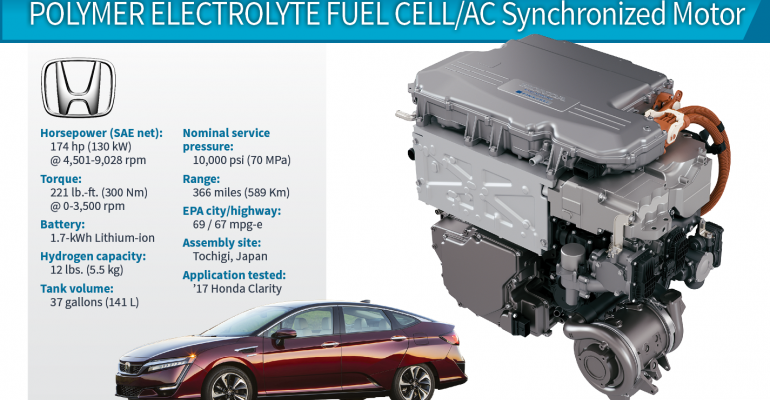Imagine a zero-emissions vehicle that has a range of 366 miles (589 km) and can be totally refueled in as little time as a conventional car. That’s the powerful value proposition behind the new Honda Clarity Fuel Cell powered by hydrogen gas.
It’s true the U.S. hydrogen refueling infrastructure is in its infancy, but the breathtaking progress automakers are making in the development of fuel-cell propulsion systems must be recognized. Automakers literally are taking technology used in spacecraft and turning it into automotive powertrains that are commercially feasible and attractive to consumers.
The 134-hp Hyundai Tucson Fuel Cell was the first FCV to appear on the Wards 10 Best Engines list in 2015. It still is a highly credible product, and happy drivers have racked up more than 2 million emissions-free miles. It’s quiet and practical, but with 0-62 mph (100 km/h) acceleration of 12.5 seconds, it’s no longer a benchmark.
The 174-hp third-generation Clarity reaches 60 mph (97 km/h) in a little over 8 seconds and is the new standard. It beats the Hyundai and Toyota Mirai FCV, which hits 60 mph in about 9 seconds, in horsepower, range and performance.
In addition to looking best on paper among its competitive set, WardsAuto editors give the Clarity top marks for off-the-line acceleration and quick response to accelerator pedal inputs. Expressway on-ramps are a breeze and we even screeched the tires in sport mode without trying.
Touting 221 lb. ft. (300 Nm) of torque and a 103-mph (166 km/h) top speed, this propulsion system delivers the most linear acceleration and fun-to-drive characteristics of any hydrogen-fueled vehicle we’ve experienced to date.
Plus, that power is delivered silently. The various “hair dryer” noises we heard from under the hood in the previous generation are gone. It’s even quieter than the fuel-cell’s BEV- and PHEV-platform siblings. “Silent as an empty library,” comments one WardsAuto judge.
Packaging, a big issue with FCVs, is another benchmark. The Accord-sized Clarity has a roomy back seat and will comfortably seat five.

The fuel cell powertrain is 33% more compact than the previous Clarity, and fits completely under the hood, occupying less space than Honda’s 3.5LV-6 engine. Trunk space is compromised by the hydrogen tanks sitting over the rear axle, but hydrogen storage capacity has been increased 39% compared with the previous generation Clarity, hence the class-leading range. Even so, there still is a decent amount of space for a couple of suitcases in the trunk.
And if driving an emissions-free spaceship on wheels that is roomy and fun-to-drive isn’t enough incentive, Honda offers a compelling deal: a $369 monthly lease payment for 36 months with $2,868 due at signing; a $15,000 fuel allowance; 21 days of free luxury car rentals for trips outside the refueling infrastructure and a $5,000 rebate from the state.
With these incentives and the Acura-level driving dynamics of the Clarity platform, this fuel-cell “engine” is ready for prime time despite all the unseen, insanely complex things going on under the hood.



